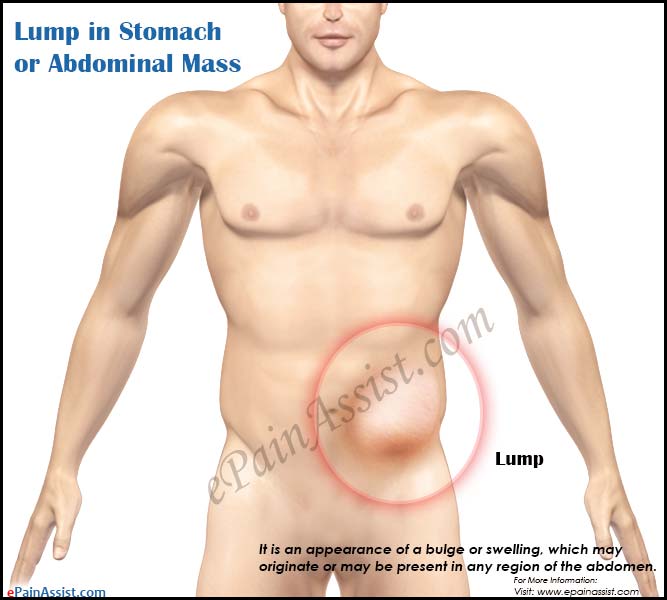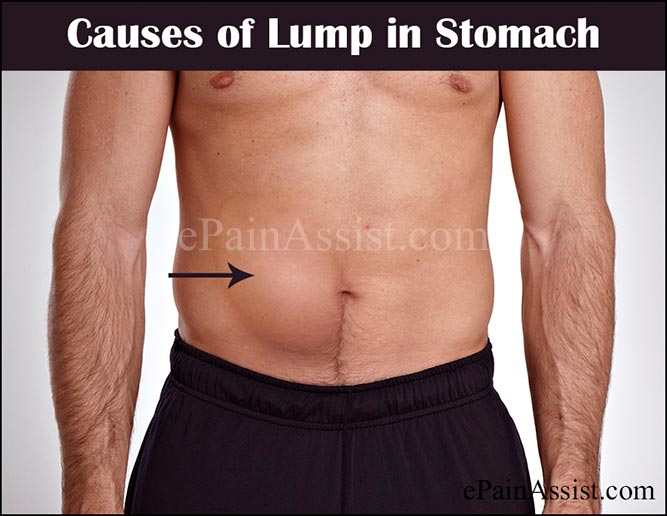What is a Lump in Stomach or Abdominal Mass?
A lump in stomach or abdominal mass is an appearance of a bulge or swelling, which may originate or may be present in any region of the abdomen. It will often feel soft; however, it can also feel firm depending on what has caused it. The lump in stomach or abdominal mass is actually an abnormal tissue collection inside the abdominal cavity. The lump or mass can be small or large; benign or malignant (cancerous), and curable or incurable. Cysts and hamartomas are some of the small benign lumps in stomach, which are fluid- filled and solid in nature and comprise of normal/benign cells. Abscess, abdominal aortic aneurysm and cancer are some of the examples of life-threatening abdominal masses, which warrants prompt medical attention. If the lump in stomach is accompanied by other symptoms such as pain, fever, vomiting etc., then also immediate medical attention is needed.

Causes of Lump in Stomach or Abdominal Mass
The most common cause of a lump in stomach is hernia. Hernias develop when the patient has strained his/her muscles by heavy lifting or have been coughing for a prolonged period of time. Constipation can also cause hernia. Hernia is a condition where the internal organs push through the muscles of the abdomen. Surgery can easily correct hernias. In rare cases, the lump in stomach or abdominal mass may be due to an undescended testicle, lipoma or a harmless hematoma, or lipoma. Lump in stomach can also be due to a cancerous tumor.

There are different types of hernias of which 3 of them can produce a noticeable lump in stomach or abdominal mass:
Lump in Stomach or Abdominal Mass Caused Due to Umbilical Hernia: An umbilical hernia resembles an inguinal hernia, but it develops around the umbilicus or navel and is more localized. Umbilical hernia most commonly occurs in babies and usually resolves on its own, as the wall of their abdomen heals. The characteristic sign of an umbilical hernia is outward protrusion or bulging of the belly button when the babies cry.
In cases where the umbilical hernia doesn’t heal on its own and the child has reached 3 years of age, then surgery is needed to repair it. Complications of umbilical hernia include obstruction of the bowels or lack of blood supply to the intestines.
Inguinal Hernia: This type of hernia develops when there is weakness in the wall of the abdomen due to which a segment of the intestine or some other soft tissue protrudes through that weak part. Patient feels or can see a lump in the abdomen and pain is felt upon coughing, lifting or bending. Some patients may not experience any symptoms until there is worsening of the condition. The complications of inguinal hernia are same as umbilical hernia.
Incisional Hernia: This type of hernia develops from weakness in the abdominal wall where a surgical cut or incision has been made during a surgery. Treatment of incisional hernia comprises of corrective surgery.
Lipoma: Collection of fat under the skin which forms a lump is known as lipoma. The bulge of lipoma feels firm and rubbery to touch and can move slightly when it is pushed. The growth of a lipoma is very slow. Lipomas can develop anywhere on the body including the abdomen and are benign in most of the cases. Surgery is needed to remove a lipoma, but is not usually required.
Hematoma: Lump in stomach or abdominal mass may also be caused due to hematoma. This is a condition where there is accumulation of blood under the skin. This blood seeps from the surrounding broken blood vessels. Trauma/injury is the most common cause of a hematoma. If there is appearance of hematoma on the abdomen, then there is also appearance of bulge and skin discoloration. Treatment is not usually required for hematomas as they tend to resolve on their own.
Undescended Testicle: When the fetus develops in the uterus, the formation of testicles takes place in the abdomen and later descends into the scrotum. Sometimes, one or more of the testicles fail to completely descend resulting in a small lump near the area of the groin in newborn baby boys. Surgery or hormone therapy can be done to bring the testicle back into its normal position.
Tumor: This is not that common a cause for lump in stomach or abdominal mass. However, if there is formation of a cancerous or benign tumor on an organ in the abdomen or in the muscles or skin, then it causes a lump or mass to develop in the abdomen. Treatment of this condition depends on the location of the tumor and the type of the tumor.
Other Causes of Lump in Stomach or Abdominal Mass
- Abdominal aortic aneurysm.
- Cholecystitis.
- Bladder distention.
- Crohn’s disease.
- Stomach, colon, liver and kidney cancer.
- Bowel obstruction.
- Abdominal scars or adhesions.
- Gallbladder tumor.
- Diverticulitis.
- Hydronephrosis.
- Hepatomegaly.
- Neuroblastoma.
- Pancreatic abscess.
- Ovarian cyst.
- Splenomegaly.
- Pancreatic pseudocyst.
- Volvulus.
- Uterine fibroids.
- Obstruction of the uretero-pelvic junction.
Signs & Symptoms of Lump in Stomach or Abdominal Mass
Other symptoms accompanying a lump in stomach or abdominal mass depend on the underlying cause and include:
- Pain in the abdomen.
- Change in appetite.
- Constipation, irregular bowel movements or diarrhea.
- Urinary changes, such as pain with urination, excessive urination or little urination.
- Pain is felt when lifting weights.
- Jaundice may be present.
- Rapid weight gain or loss of weight.
Serious Symptoms of Lump in the Stomach or Abdominal Mass Which Indicate a Fatal Condition Include:
- Stomach lump or abdominal mass which is rapidly growing.
- Pulsating abdominal mass.
- Development of a new lump or mass in the abdomen with acute abdominal pain.
Diagnosis of Lump in Stomach or Abdominal Mass
A thorough physical exam and medical history of the patient is taken. The patient may also be asked to strain or cough while the doctor is conducting the exam. Other things which will be taken into account include the time of appearance of the lump, whether there has been any change in the location or size of the lump and what other symptoms the patient is having. The doctor also tries to identify the location of the lump or mass and tries to assess whether the mass is mobile or rigid. Other characteristics, such as if there is any pulsation or peristalsis in the mass is checked to arrive at the correct diagnosis as to cause of the lump or mass in the stomach.
If the cause of the lump in stomach is hernia, then it is easily diagnosable during the physical exam. If the abdominal lump is not a hernia, then further testing is required.
Blood tests are also done and include blood urea nitrogen (BUN) and a complete blood count. Creatinine, and liver function tests are also done including albumin, international normalized ratio (INR), serum amylase and total bilirubin (TBIL) and partial thromboplastin time (PTT). Serum glucose is done if end-stage liver disease is suspected.
If an abdominal mass or lump is thought to be because of a tumor, then imaging tests such as ultrasound, CT scan, MRI scan and biopsy are done to assess its location and extent. Biopsy will help in determining if the tumor is benign or malignant.
Treatment of Lump in Stomach or Abdominal Mass
Treatment for lump in stomach or abdominal mass depends on the cause of the lump and includes watchful waiting where the patient is just monitored, medications and surgery. Medications are given to relieve pain if any. Some simple causes of a stomach lump (such as cysts and hematoma) do not need any treatment and resolve on their own. Surgery is needed if the abdominal mass is hernia, bowel obstruction or cancer etc. If the stomach lump or abdominal mass is due to cancer, then extensive treatment is required, which comprises of surgery, chemotherapy and radiation therapy.
Potential Complications & Prognosis of Lump in Stomach or Abdominal Mass
The complications and the prognosis of lump in stomach or abdominal mass depend on the diagnosis of the underlying condition, which has produced the abdominal mass. The causative condition can be mild and treatable, which makes the likelihood of complications less and gives a favorable prognosis. If the cause of the stomach lump or mass is serious or life-threatening, then the situation becomes a medical emergency. Depending on the causes of stomach lump or abdominal mass, and if not treated on time, the complications include:
- Ascites.
- Incontinence.
- Gastrointestinal perforation and sepsis.
- Permanent damage to the reproductive tract, which results in infertility.
- Permanent liver damage.
- Permanent kidney damage.
- Permanent pancreas damage.
- Secondary obstruction of the large and small intestine.
- Ruptured aortic aneurysm.
- Spreading of infection.
- Spreading or metastasis of cancer.
